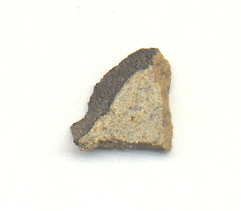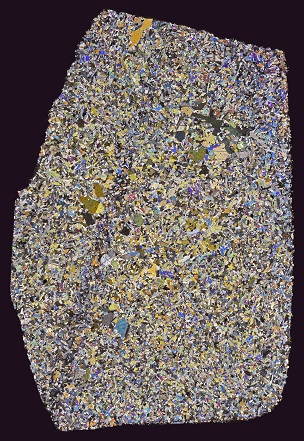Agoult

EucriteMost common type of achondrite meteorite and a member of the HED group. Eucrites are basalts composed primarily of pigeonite and anorthite (An60-98). Eucrites have been placed into three subgroups based on mineralogical and chemical differences. • Non-cumulate eucrites represent the upper crust that solidified on a magma ocean after Click on Term to Read More
Monomict, noncumulate
(Residual)
Found March 2000
30° 33′ N., 4° 54′ W.
An 82 g stone with fresh fusion crustMelted exterior of a meteorite that forms when it passes through Earth’s atmosphere. Friction with the air will raise a meteorite’s surface temperature upwards of 4800 K (8180 °F) and will melt (ablate) the surface minerals and flow backwards over the surface as shown in the Lafayette meteorite photograph below. Click on Term to Read More was found in Morocco. Many paired stones were subsequently recovered, bringing the total known weight to over 650 g. This eucriteMost common type of achondrite meteorite and a member of the HED group. Eucrites are basalts composed primarily of pigeonite and anorthite (An60-98). Eucrites have been placed into three subgroups based on mineralogical and chemical differences. • Non-cumulate eucrites represent the upper crust that solidified on a magma ocean after Click on Term to Read More has an unbrecciated, homogeneous, very fine-grained granulitic texture composed of pyroxeneA class of silicate (SiO3) minerals that form a solid solution between iron and magnesium and can contain up to 50% calcium. Pyroxenes are important rock forming minerals and critical to understanding igneous processes. For more detailed information, please read the Pyroxene Group article found in the Meteoritics & Classification category. Click on Term to Read More (~100 µm) and plagioclaseAlso referred to as the plagioclase feldspar series. Plagioclase is a common rock-forming series of feldspar minerals containing a continuous solid solution of calcium and sodium: (Na1-x,Cax)(Alx+1,Si1-x)Si2O8 where x = 0 to 1. The Ca-rich end-member is called anorthite (pure anorthite has formula: CaAl2Si2O8) and the Na-rich end-member is albite Click on Term to Read More (~50 × 300 µm). Opaques present include ilmeniteTi-Fe oxide, TiFeO3, found in achondrites, lunar mare basalts, and shergottites. Ilmenite forms as a primary mineral in mafic igneous rocks. It crystallizes relatively early out of a magma before most of the other minerals, and as a result, the heavier crystals of ilmenite precipitate to the bottom of the magma Click on Term to Read More, Ti-chromite, and FeS, while silicaSilicon dioxide, SiO2. in the form of monoclinic tridymiteSilica group mineral in which the tetrahedra occur in sheets. Tetrahedra alternately point up or down to share oxygen with tetrahedra of other sheets, forming six-sided rings perpendicular the sheets. Tridymite has a fairly open structure and accommodates Na+, K+ and Ca2+; charge balance is achieved by Al3+ ↔ Si4+. was formed by slow cooling below 400°C following low degrees of partial meltingAn igneous process whereby rocks melt and the resulting magma is comprised of the remaining partially melted rock (sometimes called restite) and a liquid whose composition differs from the original rock. Partial melting occurs because nearly all rocks are made up of different minerals, each of which has a different melting Click on Term to Read More during reheating events (Ono et al., 2018).
Agoult probably experienced metamorphism at depth and at high temperatures in which pyroxene and plagioclase were recystallized to form 120° triple junctions. In their studies of a small number of metamorphosed eucritesMost common type of achondrite meteorite and a member of the HED group. Eucrites are basalts composed primarily of pigeonite and anorthite (An60-98). Eucrites have been placed into three subgroups based on mineralogical and chemical differences. • Non-cumulate eucrites represent the upper crust that solidified on a magma ocean after Click on Term to Read More, Yamaguchi et al. (2009) determined that a few of them exhibited differences from Main Group–Nuevo Laredo trend eucrites in that they show varying degrees of LREE depletion with positive Eu anomalies. They believe these features are the result of rapid partial melting caused by magmaMolten silicate (rock) beneath the surface of a planetary body or moon. When it reaches the surface, magma is called lava. Click on Term to Read More plume intrusions and/or impact events, with subsequent melt extraction. These reheating events were superimposed over a protracted metamorphism that was already occurring within the deep crustOutermost layer of a differentiated planet, asteroid or moon, usually consisting of silicate rock and extending no more than 10s of km from the surface. The term is also applied to icy bodies, in which case it is composed of ices, frozen gases, and accumulated meteoritic material. On Earth, the Click on Term to Read More. The team proposes to call these eucrites (e.g., Agoult, A-87272, DaG 945, and NWA 2362) ‘residual eucrites’, which have lost a partial melt. This melt phase in turn contaminated the Main Group–Nuevo Laredo trend eucrites to produce the Stannern trend eucrites.
A study of the volatization of zinc isotopes in HEDs was conducted by Panielloa et al. (2012). Their data show that unbrecciated eucrites like Agoult were isotopically heavier than brecciated eucrites with regards to Zn, and also contain lower Zn concentrations. They suggest that unbrecciated eucrites likely represent very early crustal material that was ejected from the surface of VestaThird largest and fourth brightest asteroid; it was discovered in 1807 by Heinrich Olbers and named for the ancient Roman goddess of the hearth. 4 Vesta has a basaltic surface composition and an average density not much less than that of Mars. Evidently lava once flowed here indicating that the to form the Vestoids, while ensuing chondritic impacts produced the brecciated nature of the much larger parent asteroid resulting in its unique Zn isotopic systematics.
It is noteworthy that Agoult has been described by some investigators as having elemental, chemical, and textural characteristics similar to those of the ungroupedModifying term used to describe meteorites that are mineralogically and/or chemically unique and defy classification into the group or sub-group they most closely resemble. Some examples include Ungrouped Achondrite (achondrite-ung), Ungrouped Chondrite (chondrite-ung), Ungrouped Iron (iron-ung), and Ungrouped Carbonaceous (C-ung). Click on Term to Read More eucrite-like achondriteAn achondrite is a type of stony meteorite whose precursor was of chondritic origin and experienced metamorphic and igneous processes. They have a planetary or differentiated asteroidal origin where the chondritic parent body reached a sufficient size that through heating due to radioactive decay of 26Al (aluminum isotope) and gravitational Click on Term to Read More Ibitira. A Pb–Pb age based on plagioclase was calculated for Agoult by Iizuka et al. (2013) and determined to be 4.5322 (±0.001) b.y. Utilizing relatively large zircons (up to 80 µm) present in Agoult, Iizuka et al. (2014) determined a Pb–Pb age of 4.5545 (±0.002) b.y.; this age is thought to represent the time of high-temperature metamorphism in the basaltic crust. By contrast, the precisely calculated Pb–Pb age for Ibitira, 4.55675 (± 0.00057) b.y. as reported by Iizuka et al. (2014), is slightly older. Any difference in the ages of these two meteorites might be understood in consideration that the age of Ibitira is interpreted to represent the time of onset of thermal metamorphism. In addition, the crystalization temperature of zirconOrthosilicate mineral, Zr(SiO4), observed in all terrestrial rocks type and in ordinary chondrites, eucrites, mesosiderites, and lunar rocks. formation was calculated based on Ti-thermometry, with the Ti content of 37–55 ppmParts per million (106). Click on Term to Read More corresponding to ~905 (±32) °C. Utilizing this temperature combined with Ce-oxybarometry, they determined that the zircon was formed under reducingOxidation and reduction together are called redox (reduction and oxidation) and generally characterized by the transfer of electrons between chemical species, like molecules, atoms or ions, where one species undergoes oxidation, a loss of electrons, while another species undergoes reduction, a gain of electrons. This transfer of electrons between reactants Click on Term to Read More conditions in the absence of any oxidizingOxidation and reduction together are called redox (reduction and oxidation) and generally characterized by the transfer of electrons between chemical species, like molecules, atoms or ions, where one species undergoes oxidation, a loss of electrons, while another species undergoes reduction, a gain of electrons. This transfer of electrons between reactants Click on Term to Read More aqueous fluid.
The photo below is an excellent petrographic thin sectionThin slice or rock, usually 30 µm thick. Thin sections are used to study rocks with a petrographic microscope. micrograph of Agoult, shown courtesy of Peter Marmet. 
Photo courtesy of Peter Marmet






